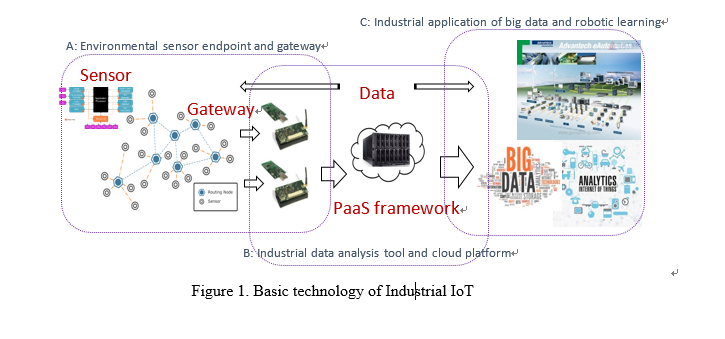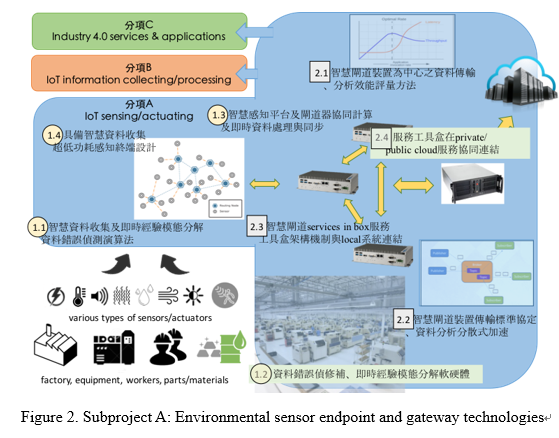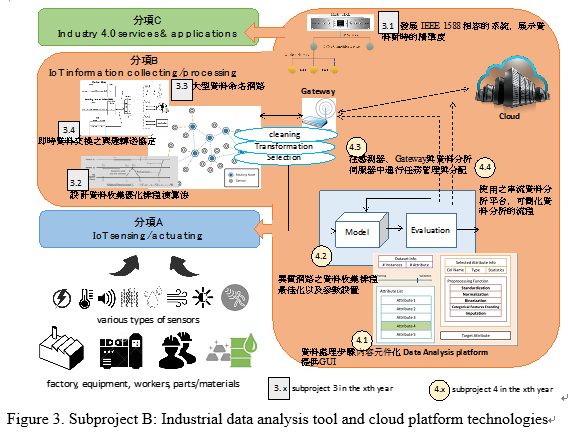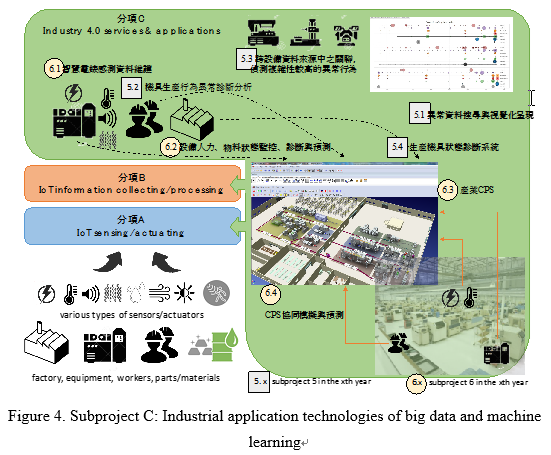Tien-Fu Chen and Shiao-Li Tsao
With the rapid development of chips, the internet of things (IoT) and big data technologies, increasing plant capacity, reducing costs of manpower, operation and maintenance, and attaching importance to environmental protection and sustainable management through Information and Communication Technology (ICT), are a few important demands of the recently popular topic, Industry 4.0. In view of the rapid growth of internet of everything and industrial demand, NCTU, Advantech and other related companies established a university level research center, “IoT Intelligent System Research Center” this year (2015). The Center comprises three main laboratories: Intelligent Video Analytics Lab, Robotics Lab and IoT Embedded PaaS Lab, to carry out a five-year cooperation project. Among them, IoT Embedded PaaS Lab is led by professors of the Department of Computer Science, NCTU. In traditional data processing, data are transmitted to the cloud for centralized computing, and the huge loading from massive data transmission may cause the turnaround time between data processing and plant decisions to be longer than expected. Distributed computing allows programs, storage and computing requirements to be closer to the devices, enabling feedback time to be within expectation and making complex prognosis possible via a powerful centralized cloud data center. This concept, known as fog computing, is one of the key technologies of IoT and big data for future applications.
Pertaining to the research topics of “IoT Intelligent System Research Center”, Professors Chen Tien-Fu, Tsao Shiao-Li and Jiun-Long Huang of the Department of Computer Science, NCTU, together with National Taiwan University Professor Chi-Sheng Shih), National Chung Cheng University Professor Peng-Sheng Chen, and Professor Tay-Jyi Lin), National Taiwan University of Science and Technology Professor Yuh-Jye Lee, formed an inter-university expert team, and successfully applied to the Ministry of Science and Technology for Industrial Fundamental Technology Projects of “Industrial Internet of Things Technology” funding. The main objective of this project is to build the infrastructure for industrial IoT in order to provide for large-scale data collection and analysis, as well as an industrial intelligent PaaS system. The project comprises three research topics: (A) environmental sensor endpoint and gateway: provide data collection and reliable software for smart sensor endpoint, and distributed gateway system with intelligent data analysis; (B) industrial data analysis tool and cloud platform: provide a massive and large-scale data collection framework and data stream analysis for an industry intelligence system and the establishment of an intelligent deployment platform; and (C) an in-depth study of industrial application intelligence: based on industrial equipment maintenance, diagnosis, prognosis and abnormal event detection of big data.


Subproject A: Environmental sensor endpoint and gateway
Due to the increased hardware efficiency, related signals from existing sensors’ indirect, desirable measurements have been used in recent years, capturing appropriate signals through high-end signal processing algorithms and empirical mode decomposition (EMD) which is very popular in Earth Science (earthquake, weather, ocean current, etc.), mechanics (vibration and failure analysis), etc., in recent years. In a smart factory environment, environmental sensor endpoints deployed in the factory are responsible for transmitting various signals to the sensor hubs, where the data are then transmitted to the data center for analysis. An important condition for realizing such smart industrial production environment is the use of cost-saving and efficient methods in obtaining a large amount and wide variety of signals. Through an in-depth study of EMD algorithms, we hope to provide efficient and low power-consuming software and hardware IP. Transient faults (soft error) in the hardware system are intermittent errors due to external events (e.g. lightning, unstable power supply components, energetic particle collision in the environment, etc.). These external events normally do not cause permanent damage to the hardware, but may result in incorrect program execution due to data access error or wrong execution path. In recent years, the maturity of subjective and objective conditions has led to an unprecedented growth in software and hardware technologies. Smaller and faster transistor process technologies result in a significant improvement in microprocessor performance, and the multi-core processor system has become the mainstream of the computing system. The demand for low voltage/ultra-low voltage chips has also increased significantly with the maturity of application requirements. However on the other hand, these developments have caused chips to be easily affected by transient faults, lowering the system’s reliability.
The environmental sensor endpoints and sensor hubs deployed in factories require continuously stable and power-saving operation. However, they experience a harsher factory environment such as mutual interference between electronic devices, and environmental factors like extreme temperature and humidity, and vibration, causing the system which instead leads to unreliable operation. Though hardware reliability could be enhanced through technologies such as ECC, parity and redundant components during hardware design, these methods significantly increase the hardware design’s complexity and manufacturing cost. We hope to enhance the system reliability through software technologies under the precondition of not changing the hardware design.

Subproject B: Industrial data analysis tool and cloud platform
The main focus of this subproject, industrial data analysis platform and cloud platform technologies, is the study of key technologies required for data collection and analysis. It comprises two key technologies: real-time data collection and cloud data analysis tool.
1. Real-time Data Collection
Big data is the critical basis of Industry 4.0. Hence, real-time data collection is essential for production process analysis. In traditional production processes, data collection is by batch, whereby each production equipment and machine after gathering machine data, stores them at their local ends, before uploading to the cloud via the internet. In the past decade, the development of automated machines and tools has significantly increased the degree of automation in production. Various technologies in real-time monitoring are also becoming increasingly mature. However, the main purpose of real-time monitoring is to monitor the status of equipment and machines, with the focus on standalone devices.
In Industry 4.0, production machines and tools are connected via the internet. Hence, various data regarding production machines and tools will be highly correlated, especially timing correlations. The traditional data collection method through standalone equipment is unable to provide the temporal relations between the production data of different production machines and tools. Also, in Industry 4.0, production machines and tools will have high flexibility to cope with production process optimization. Therefore, besides the existing stationary machines and tools, a large amount of mobile machines and tools will be added. Data collection is no longer restricted to the data detected from stationary machines and tools. All data in the production environment have significant influence on production decisions, including the position of wheeled robots and the temperatures of various areas in the factory. The time tagged on most data is largely based on the sensor’s real-time clock. However, due to the aging of crystal oscillators and decreased battery power, frequency drift may occur, resulting in data timing offset; thus the correctness of the real-time clock may be compromised. Data timing offset will result in the disability to correctly determine the correlation of the various data from the sensor data when the event occurs. Real-time clock error may also cause system control error, resulting in many possible severe consequences.
The purpose of real-time data collection is to calibrate the real-time clock of the factory’s various sensor controllers, and increase the timing correctness of sensor data (include data collected by wired and wireless sensors), so that timing errors of the data are within a controllable range.
2. Data stream analysis platform
With the accumulation of digital data in the current digital lifestyle, social media and IoT, big data technology has become a popular IT terminology. The technology carries out data analysis and data mining on the massive data generated nonstop by hardware and software, such as rapid capture devices and apps, and the extraction of valuable and hidden knowledge from the data, bringing profit and value to the relevant industries.
Due to the characteristics of big data, when raw data are generated from equipment with ICT features, such as transport equipment, production equipment and home appliances, they are transmitted to the backend via the gateway. However, as raw data normally include noise, they have to go through data preprocessing, which includes selection, cleaning and transformation, to become useful data. Research analysts carry out data mining on these processed data, build data mining models and install them in the sensor networks. When carrying out data analysis and data mining, data analysts need to have a certain degree of understanding regarding the data stream analysis process. Persons without data analysis background have to spend time studying and familiarizing themselves with the process before being able to carry out data analysis and knowledge mining. Hence, we hope to propose three improvements for the above problems:
(1) Segmentation technique of big data preprocessing: Distribute the processing analysis steps into different devices, sensors and gateways, and carry out data transformation or filtering on the equipment or devices. This not only saves time on data transmission and eases bandwidth congestion, but also reduces the load on backend data analysis server storage and processing of the analysis data.
(2) Development of data stream type analysis and mining: As sensor data are a continuous input model of data, data are transmitted nonstop to the backend via the gateway. Most data analysis algorithms provided by existing open-source data analysis and mining software are unable to process and analyze massive stream type data directly. Hence, determining how to use the open-source data analysis software to allow data analysts to easily carry out data analysis and mining on this massive stream type data is a topic for discussion in this project.
Designing simplified and easy-to-learn and -use stream data analysis interface: Construct the elemental algorithms and vision graphics, provide users with dynamic tuning, mining and visual steps, saving the users’ time in becoming familiar with the tools and understanding the operation principles of the algorithms.

Subproject C: Industrial application technologies of big data and machine learning
Modeling and simulation in a Cyber-Physical System (CPS) has made it the most important element of smart factories of Industry 4.0. Its main concept is collecting massive amounts of data on the environment, equipment, manpower, materials, etc., via IoT sensors; through data analysis, it can model the real factory’s behavior, such as environment, equipment, manpower and materials. The factory environment, equipment, production flows and processes can then be freely edited in the software environment. By inspecting historical data, policy inadequacies in factory processes, production scheduling, plant management, materials management, manpower management, and equipment operation and management can be reviewed, while further forecasting and simulating future factory production and optimizing various strategies for plant management and production, which will have direct and specific assistance in building new factories and forecasting future production capacity. The long-term target of an industrial CPS also includes the ability to instantly import data from partial or all IoT sensors in the real environment into a CPS. The data will then interact and co-simulate with partial virtual equipment, manpower, environment, material models, for more realistic analysis and real-time responses. With the simulation and decision analysis results, industrial CPS can further manage the real world applications through IoT actuators. This basic tool for Industrial CPS can also be applied to other fields that integrate IoT and cloud technology, such as the management and operation of chain stores.
Industrial CPS will have a few important core technologies that require a long period of hard work and commitment, including: (1) efficient data collection by a smart factory’s IoT sensors; (2) data analysis and model building for a smart factory’s environment, equipment, manpower and materials; (3) building a highly modular industrial CPS; (4) simulation and prognostic tools and software components; (5) real-time co-simulation and prognosis with real factory sensors and actuators and industrial CPS; and (6) status monitoring, anomaly detection, diagnosis and prognosis of environment, equipment, manpower and materials.
(1) Efficient data collection by smart factory’s IoT sensors: The smart factory collects massive real-time sensor-generated data, and these sensor data’s quality, repeatability of related information, burden on cloud transmission and storage, as well as its assistance in modelling and simulation, require in-depth analysis and discussion. The subprojects, which investigate the preprocessing of sensor data, regional intelligence and gateway design, sensor data filtering error and data-processing algorithm, are closely related to the work of this topic. Hence, this research topic shall be combined with the subprojects.
(2) Data analysis and model building of a smart factory environment, equipment, manpower, materials, etc., will be employed to investigate how best to carry out further data analysis in order to build various mathematical models of environment, equipment, manpower and materials, as well as to import them into CPS tools in a modular manner. In this topic, we shall extend smart meter’s equipment power consumption analysis techniques, and through in-depth learning skills, carry out the construction of various models.
(3) Building a highly modular industrial CPS.
(4) Simulation and prognostic tools and software components focus on building a highly scalable and highly modular industrial CPS simulator, as well as developing various simulation and prognostic tools and software components. We shall be participating in and amending an open source project’s CPS simulator, and will release the research results through open source.
(5) Real-time co-simulation and prognosis of a real factory’s sensors and actuators and industrial CPS focus on expanding real-time interaction between an industrial CPS simulator and a real factory’s sensors and actuators. This part involves the design of communication protocols and the security of IoT devices, and shall be developed jointly with the other subprojects.
(6) In this research topic, we shall extend from a smart meter’s power consumption analysis technique, and through in-depth learning skills and cooperation with subproject abnormal state detection, carry out status monitoring, anomaly detection, diagnosis andprognosis of environment, equipment, manpower and materials.
In response to the development trend of industrial demand and technology, the team formed by our department’s professors, hopes to garner the research and innovation expertise from academia and industry, and build core technologies and competitiveness for industry 4.0 era in the future.
|
Gateway |
|
Data flow |
|
PaaS framework |
|
Sensor hub |
|
A: Environmental sensor endpoint and gateway |
|
B: Industrial data analysis tool and cloud platform |
|
C: Industrial application of big data and robotic learning |